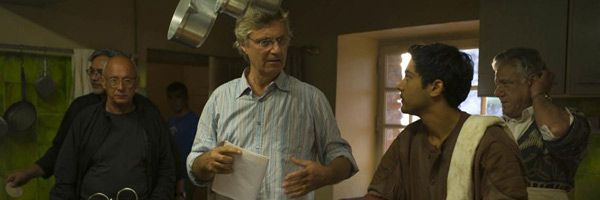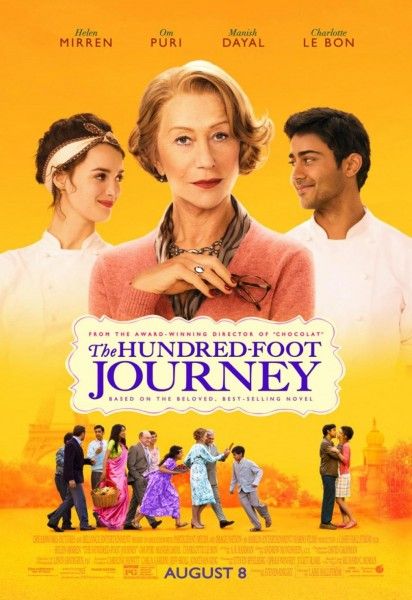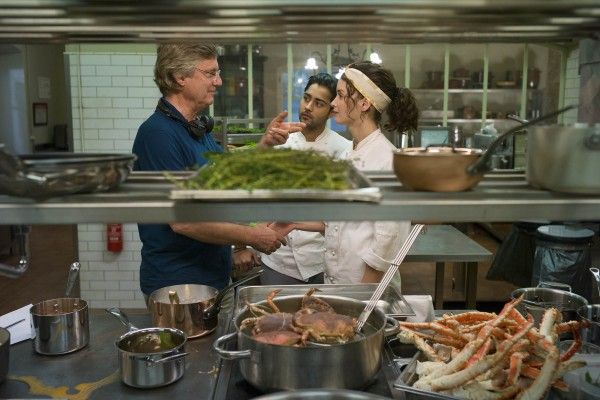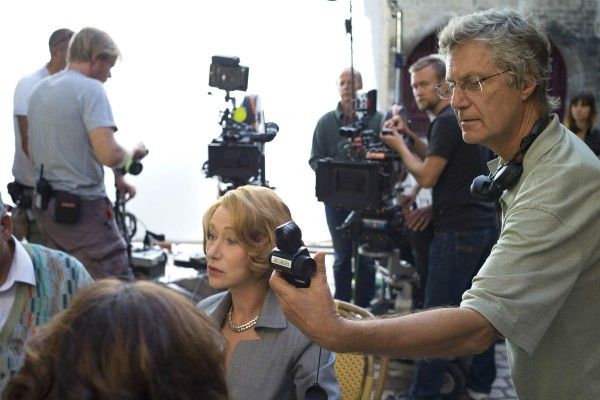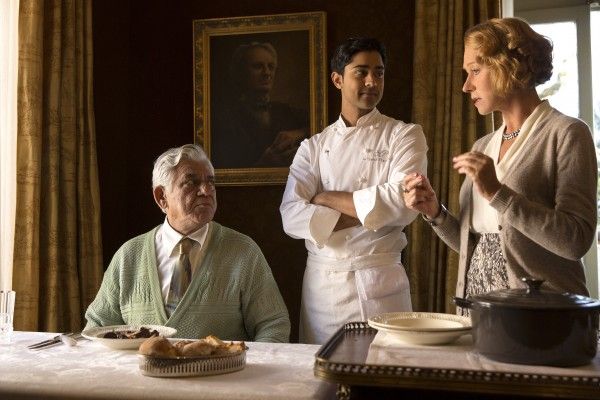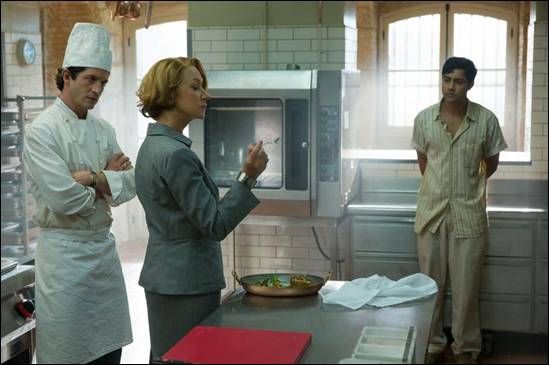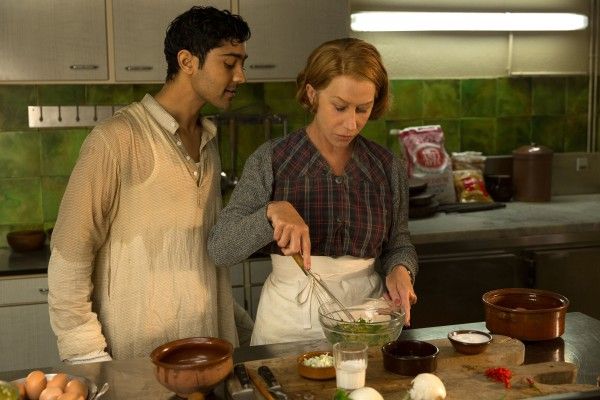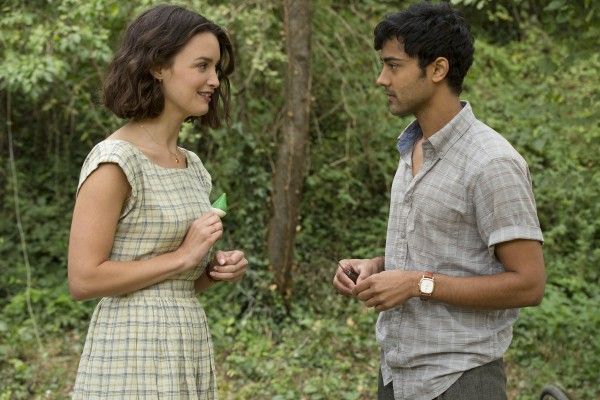Lasse Hallström’s filmmaking style and sensibility are a perfect match for The Hundred-Foot Journey, a delightful story with a powerful message directed from a screenplay written by Steven Knight based on Richard C. Morais’ best-selling novel. In a quaint village in the south of France, a heated battle erupts when a colorful new Indian restaurant opens directly across the street from a traditional establishment specializing in French haute cuisine. Amidst a culture clash of epic proportions, everyone slowly discovers that they share a lot more in common than they realized if only they’re willing to step out of their comfort zone. Opening August 8th, the film stars Helen Mirren, Manish Dayal, Charlotte Le Bon and Om Puri.
At the film’s recent press day, Hallström and producer Juliet Blake talked about the appeal of the project, how the film differs stylistically from Chocolat, how the sensuality of the performances helped make the food come alive on screen, why they wanted to avoid the usual ways filmmakers show people enjoying food, the role food plays in bringing people and different cultures together, why D.P. Linus Sandgren convinced Hallström to use film, collaborating with composer A.R. Rahman, the decision to cast Mirren and Puri together, why shooting an extra take just for fun often led to the best performance, and what Mirren brought to the film. Check out the interview after the jump.
Question: I couldn’t help but think about your film, Chocolat, another lovely little parable about taste and tolerance combined with travel-worthy locations. What is it about these gentle humanist parables with great backdrops that appeal to you so much?
LASSE HALLSTRöM: Certainly what they have in common is the interest of character and where a character can take a story. That’s truly what attracts me. It’s when a story has that. It’s wanting to tell a story truthfully and when there’s a chance for good performances that feel alive. I think they have that in common. I’m interested in relations and character, so that’s really the driving force in all my choices. The fact that they were so similar -- they’re almost siblings these films – it’s more a coincidence, because someone was selling me a script that I liked and I thought, “Oh, is it too close to Chocolat?” I didn’t think so. I certainly felt that I knew how to do this, but it also gave me an opportunity to improvise and play around and have fun with it. It’s all about the details for me. Both these scripts had that ability for the actors to play around with small observations of human behavior.
Given the similarities, how did you want to make sure this one didn’t feel like just another Chocolat? What did you want to specifically focus on to make it different stylistically?
HALLSTRÖM: Stylistically, it comes to mind right away. I didn’t want to do the montage feel of Chocolat. I wanted to do it differently, so we did longer takes. When they move in, the montage is very similar to the montage in Chocolat, so I felt I had to do this in one take. I had fun with doing longer takes. Stylistically, I tried to be different. I’m very happy to have met a Swedish director of photography, Linus Sandgren, who is a real fantastic talent with light. I also appreciate that he pretty much forced me to use film again and showed me and proved to me that film is so superior still when it comes to picking up on color and subtleties of color. If you look out at that greenery there (referring to the trees we can see through hotel window), video really can’t tell the truth about how that tree looks, such as the subtleties and the different shades of green, for example.
There are a lot of beautiful shots of food in this film, but at the same time, showing people a film of great food is like showing them a painting of a great rock and roll band that can’t convey the full sensory experience. How do you make food come alive for an audience that you can only engage in the visual sense?
HALLSTRÖM: We talked a lot about our close-ups of food. We see that daily on television. It’s dangerous territory. I hear a lot from those who have seen it so far that they get hungry from watching it. I don’t think it’s about the close-ups of the food. It’s about the sensuality of the performances. It’s not about the shots of food, because they’re pretty ordinary to me. (Laughs) (to Juliet Blake) What do you think?
JULIET BLAKE: There’s one particular moment when you see Madame Mallory (Helen Mirren) has tasted the omelette. You don’t even see her from the front. You see her arch her back. That’s an incredibly powerful moment in the film, because it’s at that point that you realize this boy, Hassan (Manish Dayal), has this gift. You’ve always known it in the way that she threw away a previous dish of his, but it’s at that moment that there’s a sort of tension. Lasse shot that so beautifully, and Helen, of course, performed it so beautifully. You just see her arch her back and you know that this is going to propel the story. It’s also the reaction to food as much as the food itself that’s really important.
HALLSTRÖM: We made a rule of not showing people enjoying the food and eating and going, “Mmmm,” and all that stuff -- anything we’ve seen in TV commercials before in slow motion. Did we have slow motion of food? We probably did, but I tried to avoid it as much as I could.
BLAKE: Very little.
How did working on the film make you rethink the role that food plays in culture and bringing people and different cultures together?
HALLSTRÖM: I didn’t rethink it. It’s a given, isn’t it, the mix of cultures and the mix of recipe ideas and trying to merge cultures and make them unite without losing the individual culture quality. It’s important going into it. It felt like a great message that we should all hold hands and know that we have so much in common. Even if we have cultural differences, there’s so much more that we have in common than we realize. Knowing that going in, it was a life-affirming message that the script had that I could certainly sign on to.
BLAKE: I grew up in a family of German Jews where German food was my life as a child, and I used to be quite embarrassed about that, because all of my very English friends had very English food. When kids used to come to my house for dinner, I didn’t like the fact that we were different. And yet, everybody else, my friends, always used to really appreciate it. So, for me, food in that way has always been quite an interesting way of combining cultures. Steven Knight, who wrote the screenplay, and I didn’t know each other before this project, but we grew up 125 miles apart from each other in English communities that had a lot of Indian families, and it was traditional to have an Indian meal on a Sunday night. A lot of English people go to their local curry house or to an Indian restaurant to have Indian food on a Sunday night. For me, the whole notion of food being something that equates to community is really important, and it is something that binds people together.
I was curious about the choice in music and when you would want to use Indian pop music or classic Indian music or French music in your regular score. How did you make those choices and how did that influence each scene that you used them in?
HALLSTRÖM: Another attraction with the story was that I could play around with merging the sounds, the languages. There are a lot of different languages that are not translated, so it’s another spice, another color of the film that I appreciated. If we could have people shift, which they do, between different languages, especially Indian people who have thousands of languages. You walk 10 meters and you have another dialect. And so, that was an attraction, and it was the same thing with music that could underscore the differences in the cultures and the similarities. We played around a lot with that. I sat with A.R. Rahman in Los Angeles and worked out the score together with him. I got the opportunity to sit in his laboratory and see him come up with ideas, so that was a fantastic part of making this film, that he invited me to the creative process there.
Was one of the pleasures of this movie bringing together Helen Mirren and Om Puri, two actors of such significant caliber who have not had the opportunity to work together previously, and finally getting them in the same room to work with each other?
BLAKE: Absolutely. I was the person that optioned the book, and Madame Mallory is not as huge a character in the book as she is in the movie. When I read the book for the first time, I immediately thought of Helen Mirren and Om Puri for the character of Papa. The book is very different to the movie, but when I read the book, I thought of both of those two and I imagined them opposite each other. I never imagined anybody else in those roles to be honest. Of course, filmmaking is really collaborative, and very early on in the process, Oprah Winfrey’s company, Harper Films, and DreamWorks and I, we would all have these long lists of actors, and I kept circling those two. For me, I knew Om from England, from East Is East and West Is West, those films and other work that he had done in England. But what I also knew about him is he’s an actor who comes from a theater background, and he’s a highly intelligent man. He works in Pakistan as well as in India, and he crosses borders himself. He’s just come back from Pakistan now acting in a play in the theater. The fact that he’s so well loved across many different cultures and countries made him somebody that I really wanted for this part. I also thought that he was not the obvious leading man opposite Helen. You could have gone for somebody quite different. I just wanted Om in that role personally, and I think Lasse did an incredible job of bringing them together in a very subtle way. I mean, the way that relationship develops is quite marvelous I personally think.
HALLSTRÖM: There are two ways of going with this material. You can go in the broader direction or in the more soft-spoken direction. I encouraged everybody throughout, even in improvisation, to do nothing pretty much, which is hard with a script that has a comedic tone that tends to encourage broader moments, but I was reining them in. Every day we had the exercise of playing it for real and doing it for real. This was an exciting part for me, too, to tell a story that has some fable-like qualities that don’t spill over to performances, because it can tend to get stylized, and I didn’t want that at all. That’s part of the charm for me as I watch it over and over again, that people are alive on that screen for me, which is so much more fun in post-production after half a year of working on it.
BLAKE: I was there for every shot of the movie, and one of the things that was great about working with Lasse was that in the first few weeks he would not do many, many takes, but he would do the takes until he knew that he had the shot that he wanted. He wouldn’t stop there. He would always do maybe one or two more, and then he’d do one just for fun. He would say, “Let’s do one more just for fun.” And that became how we knew we were near the end and we were moving on. Over the weeks, I got to know when Lasse had the shot that he wanted. I would hear the take and I’d know that that was the one. A few of us would go, “That’s the one he’ll use.” And now, seeing the film, I can remember great moments of the filmmaking with Lasse thinking, “I’ll bet he’ll use that take,” and absolutely those are the takes that are in the movie. It’s a great experience to see that.
Did the takes that were “just for fun” ever make it into the final film because maybe you allowed the actors to relax in a certain way?
HALLSTRÖM: I never lied about it. If the one before it was perfect, I wouldn’t give up. I kept rolling the camera. I gave them direction while the camera was rolling despite the fact that we were using film. I did that a lot, or at least when the shot was settled and we had just about found the right performance. I found that if you keep repeating it and you don’t break for a new slate, the performances just keep getting better and better. When you’re up there and you ask for one more for fun, there’s a certain relaxation when the actors know that the previous take was good enough for the film. So, they relax and offer something that might be even better. That’s almost like a rule that I use. Almost every second time, I use the last take, the fun one, because they’re relaxed.
You’ve worked with so many amazing actors throughout your career. How did you enjoy working with Dame Helen and what is it that she brings to a project like this?
HALLSTRÖM: She’s so smart. She knows every aspect of filmmaking. She sticks to acting for a good reason, I think, but she knows all parts of filmmaking, and she’s very creative and inventive and offers ten valid options of each moment. She improvises and she has these sparks when she’s in the moment. She’s just very smart and able to offer up all kinds of wonderful and valid choices in editing. I must say she’s always good.

